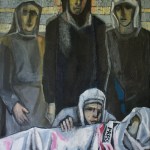
On Saturday, November 24, a solo exhibition by Abed Abdi, one of the leading Palestinian-Israeli artists, opens at the Arab-Jewish cooperative gallery in Kabri. Abdi is known as an artist and print artist who combines Arabic-local iconography and lyrical abstraction. During the 1970s and ’80s, Abdi was a social activist and member of the Communist Party, and at the same time as his studio, he contributed expressive illustrations to the major Arabic language journals.
The current exhibition concentrates on a less-known wing in the body of Abdi’s work of the last twenty years. It features drawers and boxes in which the artist creates reliefs and bricolages based on the use of used objects. These compressed worlds are located simultaneously at the ‘outside’ and ‘inside’ – on the real street and in the private memory, which is always connected to the historical story of the place. Abdi paints, sculpts, engraves and wounds his private memories into daily work materials.
For more information about other events, please visit our Facebook page:
https://www.facebook.com/events/554432301672475/?notif_t=aymt_upsell_tip¬if_id=1542574716450247
To coordinate special tours: 052-5546902, Avshalom. Gallery opening
hours: Thursday (15:30 – 18:30), Friday (11: 00-14: 00) Saturday (11:
00-15: 00)
Translated using Google translate.
location – Cabri Gallery for Contemporary Art
קיבוץ כברי, במנהרה מתחת לבניין הציבור הראשי
Time – 24/11/2018 to – 22/12/2018
Exhibition opening – 24/11/2018, שעה – 13:00
Link – http://http://www.cabrigallery.org.il/Boxed_Memories.aspx

Curator: Avshalom Suleiman
Opening and discussion gallery: 24.11.2018
Closing: 22.12.2018 at 13:00.



















